I’m thrilled to introduce you to my homemade Korean hot pepper paste (gochujang) recipe today. Yes, eventually! Over the years so many of my readers and viewers have requested the recipe for gochujang, but I thought I couldn’t make it until I visited Jamie Frater’s house in New Zealand during my Gapshida trip last year. To make good, well-fermented gochujang, you need good quality ingredients, an earthenware pot to make it in, and a sunny place for it to ferment. Making gochujang is easy, but taking care of it requires lots of patience and hard work.
Gochujang needs direct sunlight, so after you make it you need to open the earthenware pot on sunny mornings to let the sunlight hit it, and be sure to cover it in the evening. You have to stir it sometimes and turn it over from the bottom to the top so that it’ll be mixed and fermented evenly. As time goes on, your gochujang will turn shiny and turn a richer red. If you go outside to meet your friend but it suddenly rains and you forgot to close the lid, your gochujang will be spoiled.
Besides this, gochujang should not be made in the heat of summer or it will ferment too fast and explode. One of my Korean friends studying in the USA brought a container filled with his mother’s homemade gochujang on the airplane. He took it in his carry on. A long time ago, it was possible for people to bring gooey stuff like hot pepper paste, soybean paste, and even kimchi on an airplane. We have so many funny stories about this.
So my friend’s gochujang exploded on the airplane. Store bought gochujang is processed to stop fermenting, but homemade gochujang never stops, just like kimchi. The gas from the fermentation process kept pushing the lid of the container until it blew up. My friend’s mother must have packed it tightly with plastic bags and tape.
I’m living in an apartment in Manhattan without a patio, so it seemed impossible for me to make something that needs lots of direct sunlight to ferment well. Well-fermented gochujang is really delicious, and a totally different flavor from gochujang bought in a store. For a delicious meal you can simply mix it with warm rice, chopped kimchi, and toasted sesame oil.
So on my Gapshida trip, Korean food fan Jamie Frater invited me to his house to cook together. We filmed my popcorn chicken gizzard recipe video and the next day we filmed this gochujang video. The cameraman, Ryan Sweeney, is also a big fan of Korean food.
Jamie was waiting for me with all the ingredients for gochujang as well as Korean earthenware pots: onggi. He brought these from a trip to Korea that he won in a Korean food blog contest 2011 on the basis of his Korean food writing.
This Korean gochujang was made in New Zealand and taken care of by Jamie for months. It’s really international!
Makes about 16 quarts
Ingredients
- 2 pounds of barley malt powder (yeotgirem)
- water
- 10 cups of sweet rice flour
- 8 cups of rice syrup
- 4 cups (1½ pounds) of fermented soybean powder (mejugaru)
- 16 cups (1.6 kg) of hot pepper powder
- 4 cups of kosher salt
Directions
- Mix 8 liters (32 cups) of water and 2 pounds of barley malt powder (yeotgireum) in a large basin
- Strain the mixture and put it in a large heavy bottomed pot.
- Heat it up on the stove for about 20 minutes until it’s warm. Dip your finger in to test it: it should be warm, not hot.
- Remove it from the heat and add sweet rice flour. Mix well with a wooden spoon.
- Let it sit for 2 hours. The liquid on the surface will look a lot clearer, and it will taste a little sweet.

- Bring to a boil for about 2 hours over medium high heat, until it reduces by ¼-⅓ (about 28-30 cups).
*tip: Stir occasionally with a wooden spoon so it doesn’t burn to the bottom of the pot.

- Add the rice syrup and mix well.
- Remove from the heat and wait until it completely cools down.
- Add mejugaru and mix well. Then add hot pepper powder and mix well. Lastly add salt, and stir until there are no lumps in the paste.


- Transfer it to an earthenware pot or glass jar and cover with mesh or cheesecloth before closing the lid.

- It will take about 2-3 months to properly ferment. During that time it’s best to open the lid and let it sit in the sunlight during the daytime, and close it at night.
Jamie updated me recently about his gochujang with a few photos and emails. I missed the gochujang a lot! Jamie loves the texture and flavor of it, which made me very happy. Thank you very much Jamie for your effort taking care of the gochujang and updating us! Many of my readers will be encouraged to make their own homemade gochujang because of him.
He emailed:
“The gochujang came out great! It is a little thicker than commercial gochujang but I don’t think that is a problem at all. The flavor is deeper and slightly less salty than store bought pepper paste which is good I think. The hot New Zealand summer sun took great care of our precious paste! I can’t wait to see our video! I have attached 5 of the best photos I took of the gochujang.”
Well fermented gochujang! The top layer looks dark red and a little dry! I can almost smell the aroma from this photo!
Beautiful gochujang is showing off its bright red color! Thank you my gochujang! You grew up well, thanks to Jamie! : )
On the left is homemade gochujang, and on the right is store-bought gochujang. A big difference!
Maangchi's Amazon picks for this recipe
It's always best to buy Korean items at your local Korean grocery store, but I know that's not always possible so I chose these products on Amazon that are good quality. See more about how these items were chosen.





















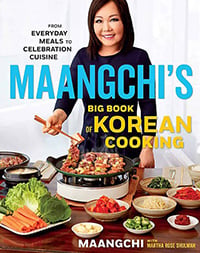





















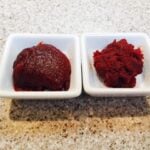
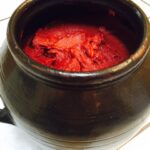
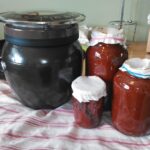
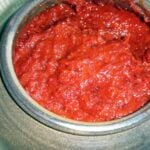
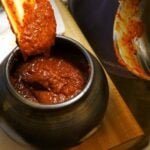
Hello Maangchi,
I am about to try your recipe, but I have halved the quantity, so it will fit in my small onggi. Probably all the gochujang I could use for a long time. I could certainly ferment it outdoors, but I would want to cover it with an insect screen. I have one for some of my larger onggi (currently occupied with kimchi) but I don’t have one that is a good size for my smaller onggi. It would need to be between 6″ and 7″ diameter to fit properly. These insect screens are a fine mesh cylinder with a rubber gasket that fits snuggly against the crock, topped by a glass lid. So it would eliminate the work of having to remove the lid when the sun shines, while protecting the ferment from rain and insects (not sure what to do about the racoons, though). Anyway, do you know what I am talking about and where I might get a smaller one of these lids online?
First, I wish you good luck with making delicious gochujang!
Yes, when I visited Korea a few years ago to learn about temple food, I went to a temple. During my visit, the monk showed me her collection of earthenware crocks, where all kinds of pastes, sauces, and pickles were stored. I noticed that some of the crocks had glass lids. I thought it was a very clever idea to protect the contents from rain or insects.
Thank you so much for getting back to me! I realize there was one more question I wanted to ask you before I make this: I bought coarse barley malt instead of barley malt powder. I presume I can just powder it using a blender? Do you know what the coarse barley malt is typically used for in Korean cuisine? Since I last wrote you I was able to locate a (somewhat expensive) eBay source for the smaller glass/screen lids, and now I have one each of my small onggis. One of those onggis is currently occupied with making fish sauce (outdoors; too stinky for indoors! with the regular lid and a cloth to keep out insects, and tied shut with wire to deter the pesky raccoons), and soon it will be joined by its friend with a glass lid, also tied on with wire so the raccoons don’t try eating it.
No need to use a blender. There are two types of barley malt. One is in powder form, and the other is coarse. You can use coarse barley malt flakes in the same way. Mix it with water and let it settle, then just use the clear liquid that floats on top. Discard the sediment that settles at the bottom. By the way you are fermenting homemade fish sauce? Wow, it seems like you’ve really been getting into Korean cooking! “One of those onggis is currently occupied with making fish sauce (outdoors; too stinky for indoors! with the regular lid and a cloth to keep out insects, and tied shut with wire to deter the pesky raccoons) haha, so funny!
Once it’s fully fermented, does it need to be refrigerated?
I’ve never refrigerated mine. Nearly 2 years later there’s still a little left in the pot and it’s time to clean it it and make it again (which is why I’m on the page again today). We do live in a climate that allows the house to be 65 degrees most of the time. If you don’t have a cool pantry, then a fridge works.
Oh wait. It’s been nearly 3 years. It started tasting funky a few months ago.
Hello Maangchi! We’ve been wat hing your videos for a few years, and love your recipes, but my wife was recently diagnosed as having Celiac. Barley Malt powder has gluten in it, are there any replacements you recommend? A quick Google search says that Maca powder Is a substitute and behaves and tastes similarly, but I was wondering if you knew of anything.
Thank you!
Hi Maangchi,
I made your gochujang today. I just wanted to show you how it looks like:
(This is my first time on your website, I’m not sure if you can see it (photos) or not.)
See full size image
Congratulations! The gochujang looks so delicious!
Hi Maangchi
Is possible to do half of the recipe. What is the amount for make only half. Thank you . Love your YouTube channel.
Hi Maangchi, I am making this gochujang right now. I’m at the step where I boil the malted barley + water + glutinous rice flour to thicken it. I’m concerned because the mixture looks separated, like the solid parts are floating in a clear liquid, instead of a homogeneous mixture. Did I do something wrong? Is it ok to keep making gochujang with this?
See full size image
This recipe has ruined me. It is too good! I can’t buy store bought. I made this recipe last year and went through it pretty quick. I love taking a bit and mixing with apple cider vinegar. This would be my dip for my fresh spring rolls. I couldn’t get enough of it. Finally instead of halfing the recipe I made the whole amount. It’s going to take a while because it’s winter and there isn’t much light in Upper Peninsula Michigan. It will all be worth it. Thank you so much Maangchi for blessing us all with your gifts. You are truly gifted being able to make such wonderful food and being able to teach others how to cook really wonderful food too. My Korean mother gave up on me and now I impress her with my Korean cooking. I tell her I am learning from Maangchi!
My gochujang going to bed tonight.
See full size image
Your gochujang looks well fermented! Congratulations!
As much as I try to keep things tidy, usually some paste sticks to the walls of my fermentation vessel, and those little bits seem prone to mold. Is there anything to do to help with that? Is it ok to just wipe it off and let the ferment keep going?
This is an older post – but maybe you’ll still see this,
Is there a way to use Meju instead of the powder for this, and how much would I need? Powder is harder to find, but soybeans, I have a lot of those!
I ordered all the ingredients to make this in early July and most, if not all, from Amazon. It cost me around $130 USD. I know it would’ve been cheaper if I went to H-Mart in near Nassau County (long island NY) but darn Covid kept me from going that route.
I AM making this today as we speak (as I type ;-) I even ordered some Onggi/Hangari to ferment in. They’re a bit disappointing in quality (rough surfaces) but should get the job done! I just hope traditional Korean onggi like mine don’t have heavy metals in the glaze!
I’ve also made Kimchi but I got a little silly and chopped up some mugwort and put it in. It smelled a little funny at first, but now I don’t notice the mugwort.
It’s hard to get ingredients when I can’t go into any stores :-(
ALSO, my soy sauce ferment is now 1yr old (different method than Maangchi’s: I used rice koji n didn’t make bricks) & my miso paste ferment is almost 24mos old. Some of that was in plastic buckets (soy sauce) n miso was in sugar crock from Marshall’s n overflow into 32oz canning jar.
See full size image
If you get the urge again – with a little patience in most places you can order online from Hmart and it’s a lot cheaper than on Amazon. It does take longer to ship, but the ingredients were easily 1/3 of the price of Amazon’s
Hi Maangchi!
I am going to make gochujang using the recipe from your book. I would like to get the onggi to ferment the gochujang. May I know which size would you advice me to get please? The recipe makes 8 quarts (7.5litre) does that mean I have to find onggi jar that have the capacity of at least 7 litres?
Thank you Maangchi!
Azlinda
Hi Maangchi,
I will repost the same question because didn’t get an answer
Can I use a different flour for the fermented soybean flour?, because they don’t have it here in Sweden and amazon doesn’t ship to Sweden? Or can I make my own fermented soybean flour?
Kind regards Nari
Hi Nari, I’m sorry to say that you need fermented soybean flour called meju-garu. There is no substitute.
I ordered this on July 6, 2020: https://www.amazon.com/dp/B00WDO0B1Y?ref=ppx_pop_mob_ap_share
A 3lb bag for $27
Maanchi,
Hi…I wanted to let you know that when I tap the link for the hot pepper powder…it does not open a item on the amazon website page like the other links do…I really want to buy the brand that has the picture of what you use…could you please provide a active link to where I can purchase that?
Thank you so much…I love all that I am learning from your videos!
I hope to make the homemade pepper paste soon!!!
Thanks again for all you do!!!
Sincerely,
Rhonda
They don’t seem to sell their gochugaru on amazon these days.
I don’t know if you’re still looking – but Hmart does have online orders for Gochgaru, https://www.hmart.com/catalogsearch/result/index/?cat=301&q=korean+red+pepper+powder
I just take my Korean red pepper flakes and turn it into a powder in my vitamin. I work with it in small cup to 2 cup batches. It seems to work very well for me. Plus it is a lot cheaper than buying the powder version of the same thing.
Using vitamix is such a great idea!
Hi Maangchi….thank you so much for your wonderful recipes….anyway, I was just wondering, is it okay if I put fresh chilies in gochujang? because I really love spicy gochujang.
Thank you….
Is there a way to make nonspicy gochujang? If I just skip the hot pepper powder, I’m afraid the texture will be different. Is there a nonspicy powder I can use instead? Thank you!
Hi Maangchi,
Can I use a different flour for the fermented soybean flour?, because they don’t have it here in Sweden and amazon doesn’t ship to Sweden? Or can I make my own fermented soybean flour?
Kind regards Nari
Might be able to substitute light miso, but have to adjust for saltiness and additional liquid content. Or maybe not…. 망치 will know.
I made gochujang about 3 years ago now and I still have a lot left. I now learned that I cannot eat gluten, so I cannot eat barley or anything touching wheat, like the nuruk in makgroli either and maybe some meju-garu. So I cannot eat my long aged makgeoli or gochujang
I know that this is the traditional method, but have you ever heard of any way to make gochujang or makgeoli without barely or starter that uses wheat? The enzymes help make the sweetness and to ferment and digest – I wonder if there are any alternative ways to get that in Korean tradition.
There is gluten free gochujang at the store but it’s $5 for a very small bottle. I would love to have a jar of gochujang sitting next to my doenjang fermenting ^_^
Hi Maangchi, I have just bough a pack Malt Flour(Fine), can I use this to make Hot pepper paste?
Thank you.
See full size image
Is there any recommendations for a replacement for the malted barley? I have a friend that recently was diagnosed with Celiacs and must avoid all gluten containing things.
HONEY or Palm Sugar
Thank you. =)
I am growing Korean hot peppers in my garden, and have a lot of them. I am wondering if I can make gochujang with fresh peppers (and reduce the water in the recipe) or if I need to dry them first? Maybe I will make two batches, one with fresh peppers and one with dried?
Hi, thanks for your great blog. As I scour the internet for traditional gochujang recipes, I can’t find anything about benefits/drawbacks about different weather conditions during the many months of fermentation. Gochujang was traditionally made in the fall, and stored in onggi, and historically it was aged outside on a jangdokdae. The Korean peninsula has weather that is roughly similar to mine here in Vermont, although the southern parts of Korea are milder in the winter.
I have a big stoneware crock of gochujang fermenting right now, and after keeping it indoors on the ledge of a bay window where it could get some of our infrequent winter sunlight, I decided to move the whole crock onto our back porch. We’re now in a cold spell, with temperatures in the low teens, rising into the 20s during the day. I’ve seen pictures of snow-covered onggi but haven’t read anything about significant temperature fluctuations and its effect on fermenting things — whether gochujang, doenjang, or ganjang.
I would welcome your perspective on the effects of temperature on Korean fermented goods. Again, thanks for your blog! Patrick in Vermont
In your instructions you said to strain the barley malt powder mixture. Does that mean you don’t want any of the powder like how you make sikhye? Or should I just stir the water and barley malt flour until it is completely mixed and turn on the heat?
Hello,
I am here in Pyeongtaek, South Korea and would like to start a batch of gochujang. My question is; is it too late in the year? It will be fall before fermentation is complete.
Thank you!